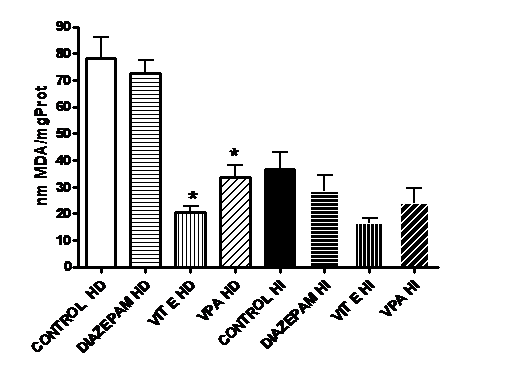Valproic acid has neuroprotective effect in an acute model of oxidative stress in rats
Keywords:
valproic acid, free radicals, cerebral cortex, neuroprotectionAbstract
The excess of the free radical production at has been implied has a common factor in pathogenesis of a big number of neurodegenerative processes, including Alzheimer’s and Parkinson’s disease and in ischemia/reperfusion induced brain damage. Valproic Acid (VPA), which traditionally has been used as an antiepileptic drug, now is proposed as a neuroprotective agent, but is not clear it’s mechanisms of action. In this paper, its effect was investigated in an acute oxidative stress model with Sprague Dawley rats, in which iron sulfate was used as injury and lipid peroxidation and carbonylated proteins were quantified at cerebral cortex, showing that it blocked formation of free radicals. Levels of MDA atcerebral cortex that received oxidative injury in the group of animals treated with VPA were 57% lower in comparison to control group, also the amount of carbonylated proteins was 65% lower in the cerebral cortex of experimental animals in contrast to control group. Furthermore, it was found that the antioxidant effect showed by the VPA, was equally significant than showed by vitamin E.
Downloads
References
[2] Halliwell B. Oxidative stress and neurodegeneration: where are we now? J Neurochem 2006; 97:1634-1658.
[3] Beckman KB, Ames BN. The free radical theory of aging matures. Physiol Rev 1998; 78:547-581.
[4] Harman AW, Maxwell MJ. An evaluation of the role of calcium in cell injury. Annu Rev Pharmacol Toxicol 1995; 35:129-144.
[5] Ratnam DV, Ankola DD, Bhardwaj V, Sahana DK, Kumar MN. Role of antioxidants in prophylaxis and therapy: a pharmaceutical perspective. J Control Release 2006; 113: 189-207.
[6] Pandya RS, Mao L, Zhou H, Zhou S, Zeng J, Popp AJ, Wang X. Central nervous system agents for ischemic stroke: neuroprotection mechanisms. Cent Nerv Syst Agents Med Chem 2011; 11(2):81-97.
[7] Qian YR, Lee MJ, Hwang S, Kook JH, Kim JK, Bae CS. Neuroprotection by valproic Acid in mouse models of permanent and transient focal cerebral ischemia. Korean J Physiol Pharmacol 2010; 14(6):435-440.
[8] Chiossi L, Negro A, Capi M, Lionetto L, Martelletti P. Sodium channel antagonists for the treatment of migraine. Expert Opin Pharmacoth 2014; 15(12):1697-706.
[9] Monti B, Polazzi E, Contestabile A. Biochemical, molecular and epigenetic mechanisms of valproic acid neuroprotection. Curr Mol Pharmacol 2009; 2(1):95-109.
[10] Ohkawa H, Ohishi N, Yagi K. Assay for lipid peroxides in animal tissues by thiobarbituric acid reaction. Anal Biochem 1979; 95(2):351-358.
[11] Levine RL, Garland D, Oliver CN, Amici A, Climent I, Lenz AG, et al. Determination of carbonyl content in oxidatively modified proteins. Methods Enzymol 1990; 186:464-478.
[12] Lowry, O. H., Rosebrough NJ, Farr AL, Randall RJ. Protein measurement with the Folin phenol reagent. J Biol Chem, 1951. 193(1):265-275.
[13] Chang TK, Abbott FS. Oxidative stress as a mechanism of valproic acid-associated hepatotoxicity. Drug Metab Rev 2006; 38(4):627-639.
[14] Chaudhary S, Parvez S. An in vitro approach to assess the neurotoxicity of valproic acid-induced oxidative stress in cerebellum and cerebral cortex of young rats. Neuroscience 2012; 225:258-268.
[15] Choi DW, Rothman SM. The role of glutamate neurotoxicity in hypoxic-ischemic neuronal death. Annu Rev Neurosci 1990; 13:171-182.
[16] De Keyser J, Sulter G, Luiten PG. Clinical trials with neuroprotective drugs in acute ischaemic stroke: are we doing the right thing? Trends Neurosci 1999; 22(12):535-540.
[17] Löscher W, Schmidt D. Increase of human plasma GABA by sodium valproate. Epilepsia 1980; 21(6):611-615.
[18] Madden K, Clark W, Lessov N. Failure of ischemic neuroprotection by potentiators of gamma-aminobutyric acid.Clin Med Res 2003; 1(2):119-124.
[19] Wang JF, Azzam JE, Young LT. Valproate inhibits oxidative damage to lipid and protein in primary cultured rat cerebrocortical cells. Neuroscience 2003; 116(2):485-489.
[20] Bjørneboe A, Bjørneboe GE, Drevon CA. Absorption, transport and distribution of vitamin E. J Nut 1990; 120(3):233-242.
[21] Frey BN, Valvassori SS, Réus GZ, Martins MR, Petronilho FC, Bardini K, et al. Effects of lithium and valproate on amphetamine-induced oxidative stress generation in an animal model of mania. J Psychiatry Neurosci 2006; 31(5):326-332.

Published
How to Cite
Issue
Section
Gaceta de Ciencias Veterinarias se apega al modelo Open Access, por ello no se exige suscripción, registro o tarifa de acceso a los usuarios o instituciones. Los usuarios pueden leer, descargar, copiar, distribuir, imprimir y compartir los textos completos inmediatamente después de publicados, se exige no hacer uso comercial de las publicaciones. Para la reproducción parcial o total de los trabajos o contenidos publicados, se exige reconocer los derechos intelectuales de los autores y además, hacer referencia a esta revista. La publicación de artículos se hace sin cargo para los autores. Los trabajos pueden consultarse y descargarse libremente, y de manera gratuita, en extenso en versión digital, desde su enlace Web institucional. Los textos publicados son propiedad intelectual de sus autores. Las ideas, opiniones y conceptos expuestos en los trabajos publicados en la revista representan la opinión de sus autores, por lo tanto, son estos los responsables exclusivos de los mismos.


